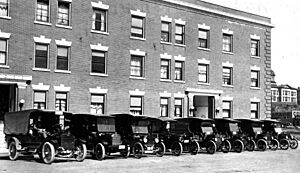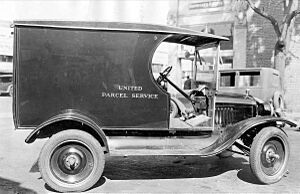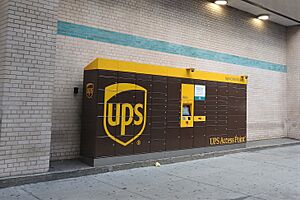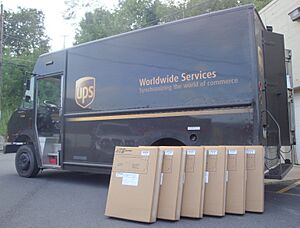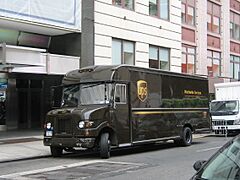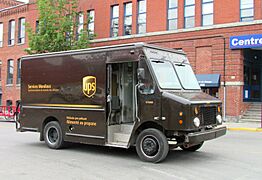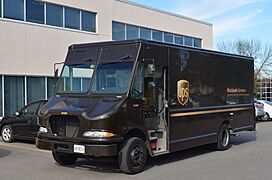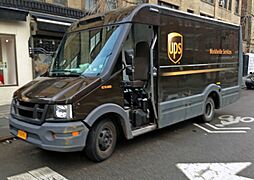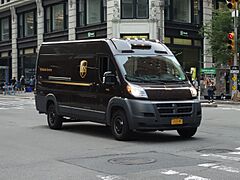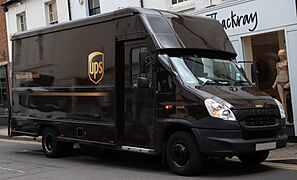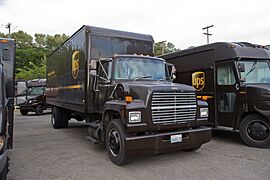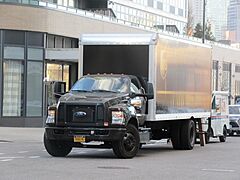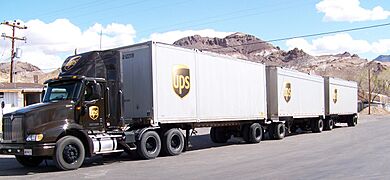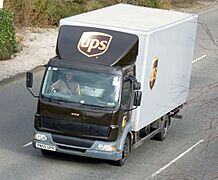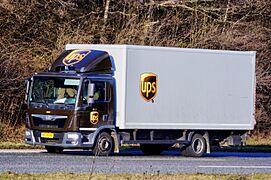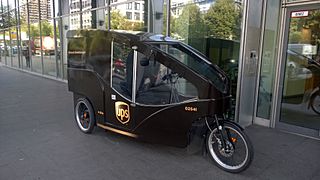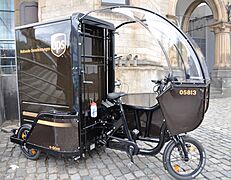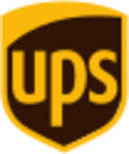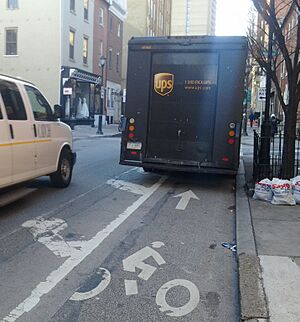United Parcel Service facts for kids
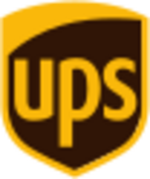 |
|
|
Formerly
|
|
|---|---|
| Public company | |
| Traded as | |
| Industry | Courier |
| Founded | August 28, 1907 in Seattle, Washington, U.S. as the American Messenger Company |
| Founder | James E. Casey |
| Headquarters | Sandy Springs, Georgia, U.S. |
|
Area served
|
Worldwide |
|
Key people
|
|
| Services | |
| Revenue | |
|
Operating income
|
|
| Total assets | |
| Total equity | |
|
Number of employees
|
c. 490,000 (2024) |
| Subsidiaries |
|
United Parcel Service, Inc. (UPS) is a big American company that delivers packages and manages supply chains all over the world. It started in 1907. UPS was first known as the American Messenger Company. It focused on sending telegraphs and messages.
Today, UPS is one of the largest shipping companies globally. It is famous for its brown delivery trucks and ground shipping services. UPS also has The UPS Store, which helps people send packages and supports small businesses. The company offers fast air shipping, including overnight and two-day options. UPS delivers to over 220 countries and territories.
UPS is the world's largest courier company by how much money it makes. In 2020, its yearly earnings were about US$85 billion. This was more than its rivals, DHL and FedEx. UPS has a huge international hub called UPS Worldport in Louisville, Kentucky. This hub is one of the busiest cargo airports in the world. UPS is also one of the biggest private employers in the United States.
Contents
History of UPS
How UPS Started
On August 28, 1907, a person named James E. Casey started the American Messenger Company. He began it with Claude Ryan in Seattle, Washington. They started with only $100. At first, most deliveries were done by walking. Bicycles were used for longer trips.
The American Messenger Company mainly delivered packages to stores. They also delivered special mail for the United States Post Office Department. This was the company that came before today's United States Postal Service. In 1913, the company bought its first delivery vehicle, a Ford Model T. Casey and Ryan then joined with another company owner, Evert McCabe. They formed a new company called Merchants Parcel Delivery. They also started combining packages going to the same area onto one delivery vehicle. This made deliveries more efficient.
In 1916, Charlie Soderstrom joined the company. He brought more vehicles as the business grew. In 1919, the company grew outside of Seattle for the first time. It expanded to Oakland, California. At this time, it changed its name to United Parcel Service.
In 1922, UPS started offering a "common carrier" service. This meant it could deliver packages for anyone, not just specific businesses. UPS was one of the few companies in the U.S. to offer this. At first, this service was only around Los Angeles. By 1927, it covered areas up to 125 miles outside the city. In 1924, UPS started using a conveyor belt system to handle packages. This helped them sort packages faster.
In 1930, UPS began its common carrier service in New York City. Soon after, it expanded to other big cities in the East and the Midwest. When UPS started delivering packages across state lines, it came under the rules of the Interstate Commerce Commission. The first city outside California where UPS used its common carrier status was Chicago, Illinois, in 1953.
UPS first used air service in 1929 through private airlines. But the Great Depression and not enough packages stopped this service. In 1953, UPS started air service again. It was called UPS Blue Label Air. This service offered two-day delivery to major cities on the East Coast and West Coast.
Growth and New Services
In 1975, UPS moved its main office to Greenwich, Connecticut. It also started serving all 48 connected states in the United States. This made UPS the first package delivery company to reach every address in these states. Also in 1975, UPS began working internationally by starting operations in Canada. In 1976, UPS started domestic operations in West Germany.
UPS Next Day Air Service began in 1985. It covered all 48 connected states plus Puerto Rico. In 1988, UPS Airlines was launched. It became the fastest-growing airline in the history of the Federal Aviation Administration. It is now the 10th largest airline in the United States. Domestic air service was added to Germany in 1989. In 1991, UPS moved its headquarters to Sandy Springs, Georgia, near Atlanta. After this, in 1992, UPS bought two companies, Haulfast and Carryfast. They were renamed UPS Supply Chain Solutions.
By 1993, UPS was delivering up to 11.5 million packages and documents every day. To handle so many customers, UPS developed new technologies in 1991. They created a handheld device called the "Delivery Information Acquisition Device" (DIAD). This device records and sends delivery information to the UPS network right away. In 1992, UPS started tracking all ground shipments electronically. In 1994, UPS.com started. It allowed customers to access information that was mostly for internal use before.
In 1995, UPS bought SonicAir to offer services for spare parts logistics. In the same year, UPS launched the UPS Logistics Group. This group helped manage global supply chains and offered advice to customers. In 1997, a strike by 185,000 members of the Teamsters union stopped UPS for 16 days. In 1998, UPS Capital was created. It helps companies grow their business with financial services. UPS bought Challenge Air in 1999 to expand its work in Latin America.
On November 10, 1999, UPS became a public company. This was the largest initial public offering of the 20th century.
UPS in the 21st Century
In 2001, UPS bought Mail Boxes Etc., Inc.. This was a network of packing and shipping stores. In 2003, the company changed the name of these stores to The UPS Store.
In 2004, UPS started in the heavy freight business. It bought Menlo Worldwide Forwarding. UPS renamed it UPS Supply Chain Solutions. In 2005, UPS bought Overnite Transportation, a trucking company. This company officially became UPS Freight in 2006.
Also in 2005, UPS started non-stop delivery service between Guangzhou, China, and the United States. On October 3, 2005, UPS bought Lynx Express. This was a large package carrier in the United Kingdom. In 2007, United Parcel Service celebrated its 100th birthday. In 2008, All Nippon Airways and UPS formed a partnership to transport cargo.
In 2012, UPS planned to buy TNT Express to grow in Europe and Asia. However, the deal did not happen because European regulators blocked it. In February 2012, UPS bought Kiala, a company that lets online shoppers pick up goods at retail stores.
In May 2019, UPS started working with TuSimple, a company that makes self-driving trucks. They carried cargo between Phoenix and Tucson, Arizona. In October 2019, UPS got approval from the Federal Aviation Administration to fly drones. This allowed UPS to deliver healthcare supplies using drones.
On January 29, 2020, UPS announced it was investing in Arrival, a UK startup. UPS ordered 10,000 electric vehicles from them. This was a step towards a cleaner fleet. In March 2020, Carol Tomé became the new chief executive officer of UPS. This was seen as a move to guide the company through changes in trade and technology.
In January 2021, UPS announced it would sell UPS Freight, its less-than-truckload freight business, to TFI International. This deal was completed in April, and UPS Freight was renamed TForce Freight. This allowed UPS to focus more on small-package delivery. In 2021, UPS reported a big jump in sales. This was partly because they focused on smaller customers during the COVID-19 pandemic.
In September 2021, UPS agreed to buy Roadie, a company that offers same-day delivery. In May 2022, UPS bought Delivery Solutions, a logistics company. In November 2022, UPS acquired Bomi Group, a European company that handles healthcare warehousing and temperature-controlled transport. In September 2023, UPS acquired MNX, a healthcare logistics company. In October 2023, UPS acquired Happy Returns from PayPal. This company handles returns for online shopping.
In January 2024, UPS announced plans to reduce 12,000 jobs. They also asked staff to return to the office five days a week. The CEO, Carol Tomé, said this was due to a "difficult and disappointing year" in 2023. In July 2024, UPS announced it would buy Estafeta Mexicana, a Mexican logistics company.
UPS Locations
United States Facilities
Louisville UPS Worldport
UPS’s main hub for air shipments is called Worldport. It is located at Louisville Muhammad Ali International Airport. This facility helps make the airport the second-busiest cargo airport in the United States. It is also the fourth-busiest worldwide.
Worldport is very large. It has:
- 290 aircraft.
- More than 20,000 employees.
- 5.2 million square feet of building space. This is about the size of 90 football fields.
- The ability to handle 115 packages every second. This means 416,000 packages flow through its facilities every hour.
Regional Air Hubs
UPS has five big regional air hubs in the United States. They are in Ontario, California; Dallas, Texas; Rockford, Illinois; Philadelphia, Pennsylvania; and Atlanta, Georgia. These hubs are important centers for sorting, transferring, and delivering packages.
European Facilities
Poland
UPS has a large package center in Mysłowice, Poland. It is 11,000 square meters in size. This facility has a conveyor belt system that can sort up to 6,000 packages per hour. It also has parking for 170 package cars. There is also a customer call center. The Mysłowice facility is more than three times bigger than the one in Katowice. Mysłowice was chosen in 2017 because it is close to many business centers and the Katowice airport. UPS has also invested in more air cargo space at this airport.
Turkey
UPS has 15 small package and four SCS (Supply Chain Solutions) facilities in Turkey. These are in cities like Istanbul, Ankara, Izmir, Bursa, and Antalya.
Asia-Pacific Facilities
Asia-Pacific Air Hub
UPS's Asia-Pacific Air Hub is at Singapore Changi Airport. It is the company's largest hub outside of the United States. It handles over 1.1 million packages every day. The hub was made 25% bigger in 2023. This was to meet the growing demand for online shopping after the COVID-19 pandemic. After the upgrade, it can process 40% more incoming packages. It can also handle 45% more outgoing packages. This allows for later pick-up times for all export services.
The hub also has special refrigerators and freezers. These can keep temperatures between -20 and 25 degrees Celsius. This helps store shipments temporarily, especially important healthcare deliveries like COVID-19 vaccines. It is part of Changi's cold chain system. This system makes sure that medicines stay at the right temperature.
Regional Hubs
UPS has five regional hubs in the Asia-Pacific region. They are in Hong Kong, Japan, Korea, Malaysia, and Thailand. These hubs are major centers for sorting and distributing packages. They handle packages moving within and between different regions.
UPS Finances
For the year 2023, UPS made US$6.71 billion in profit. Its total yearly earnings were US$90.96 billion. This was a 9 percent decrease from the year before. UPS was ranked 34th on the 2022 Fortune 500 list. This list shows the largest companies in the United States by total earnings.
How UPS Works
UPS's main job is to deliver packages and documents on time around the world. Recently, UPS has also started offering services for larger shipments (less-than-truckload) and supply chain management. These services are mostly in the U.S.
UPS divides its work into three main parts:
- U.S. Domestic Package operations.
- International Package operations.
- Supply Chain & Freight operations.
United States Shipping Services
UPS offers several services for customers in the U.S.:
- UPS Ground: This service delivers packages by a specific day. It can take up to 5 days.
- UPS 3-Day Select: For packages that are not super urgent. This service can use air or ground transport. It takes up to three days.
- UPS 2nd Day Air: For packages that need to arrive within two days. UPS also has a 2nd Day Air AM service for morning delivery.
- UPS Next Day Air: For shipments that need to arrive overnight. UPS has three levels for this:
- Next Day Air Saver: Guaranteed overnight delivery, usually in the afternoon.
- Next Day Air: Guaranteed overnight delivery between 10:30 AM and noon.
- Next Day Air Early: Guaranteed overnight delivery by 8:30 AM in big cities and 9:30 AM elsewhere.
- UPS Express Critical: This is UPS's fastest service. It delivers to all 50 states, Washington D.C., and Puerto Rico by the end of the day.
UPS also offers UPS SurePost. With this service, UPS handles packages for most of the journey. Then, the United States Postal Service (USPS) delivers them the last mile to your door.
International Shipping Services
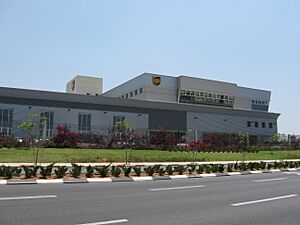
International Package operations deliver to more than 220 countries and territories. This includes shipments that start and end outside the U.S. It also includes shipments that either start or end outside the U.S.
UPS has a few international shipping services:
- UPS Standard: For shipments to Mexico and Canada.
- UPS Worldwide Expedited: For all international shipments. Usually delivered within 2-5 business days.
- UPS Worldwide Saver: Also for all international shipments. Usually delivered overnight to Canada, 2 days to Mexico, Latin America, and Europe. It takes 3 or more days to the rest of the world, all by the end of the day.
- UPS Worldwide Express: For more urgent international shipments. Similar delivery times to Worldwide Saver, but usually by 10:30 AM to noon.
- UPS Worldwide Express Plus: For Worldwide Express shipments that need to arrive earlier in the morning.
Supply Chain and Freight Services
Supply Chain & Freight (called UPS-SCS for UPS Supply Chain Solutions) includes UPS's freight forwarding and contract logistics services. It also includes other related business units. UPS's freight and logistics business offers services in over 175 countries and territories. These services include designing, carrying out, and managing supply chains worldwide. They also include freight forwarding, distribution, customs help, mail, and consulting services.
Other parts of this section include The UPS Store and UPS Capital.
Until 2021, this part also included UPS Freight. This service offered different types of trucking services in North America. UPS Freight was sold in April 2021 and is now called TForce Freight.
UPS Employees
In 2016, UPS had about 444,000 employees. About 362,000 were in the U.S. and 82,000 were in other countries. In 2023, about 330,000 UPS drivers, package handlers, and clerks were part of the International Brotherhood of Teamsters union. More than half of these were part-time workers. In 2023, a full-time UPS package delivery worker with over four years of experience earned about $95,000 per year.
In July 2023, before their contract was ending, the union threatened a strike. They wanted higher wages, better benefits, and air conditioning in delivery vans. A 10-day strike would have been very costly for the U.S. economy. The strike was called off after UPS agreed to increase starting pay for part-time workers to $21 per hour. They also agreed to other things. UPS also said that new delivery vans would have air conditioning starting in January 2024. Existing vehicles would get two fans, more ventilation, and shielding to reduce heat. All large tractor-trailers already have air conditioning.
UPS Leaders
- 1907–1962, James E. "Jim" Casey
- 1962–1972, George D. Smith
- 1972–1973, Paul Oberkotter
- 1973–1980, Harold Oberkotter
- 1980–1984, George Lamb
- 1984–1989, John W. Rogers
- 1989–1996, Kent C. "Oz" Nelson
- 1997–2001, James P. Kelly
- 2002–2007, Michael L. "Mike" Eskew
- 2008–2014, Scott Davis
- 2014–2020, David Abney
- 2020–current, Carol B. Tomé
UPS Competitors
In the United States, UPS competes with major companies like the United States Postal Service (USPS), FedEx, and Amazon Logistics. There are also smaller regional carriers like OnTrac and LSO. Around the world, UPS competes with many international companies. These include SF Express, Canada Post, TransForce, Deutsche Post (and its part DHL), Royal Mail, and Japan Post Service.
In the past, UPS mainly competed with cheaper ground delivery services. In 1998, FedEx started ground parcel delivery by buying RPS. It was renamed FedEx Ground in 2000. In 2003, DHL bought Airborne Express, expanding its work in the United States.
To compete, UPS partnered with the USPS. They created UPS Mail Innovations. This program lets UPS pick up small mail and packages. Then, they transfer them to a USPS center for the final delivery. UPS also has a service called "SurePost." This uses the UPS Ground network for packages under 10 pounds. These packages are then given to the USPS for the "final mile" delivery.
More recently, the growth of online shopping has led to new competitors. Some companies focus on specific types of deliveries. For example, the USPS says its letter carriers deliver to every U.S. address anyway. So, they claim to have the lowest fuel use per delivery.
UPS Vehicles
UPS uses over 119,000 delivery vehicles worldwide. These range from bicycles to large tractor-trailer trucks. UPS has a long-standing rule: they remove all manufacturer logos from their vehicles. This is to avoid advertising for any specific car company.
A typical UPS ground vehicle lasts 20–25 years or even longer. They are used until their structure is too weak. UPS does not sell its old ground vehicles. Instead, old vehicles are usually stripped for reusable parts. Then, they are sent to be crushed. Before crushing, all UPS logos are painted over. The vehicle is given a special number and crushed under supervision. The only exception is if a vehicle is kept for internal company use. For example, old package cars might be repainted white and used at large hubs.
Delivery Vans
UPS calls its delivery vans "package cars." They use different designs and sizes depending on the delivery route and how many packages there are. The unique rounded "bubble-nose" front and upper roofline design started in 1965. The bodies of the package cars are made by companies like Morgan Olson and Utilimaster. Older vehicles used Ford or General Motors chassis. Vehicles made in the 21st century use Freightliner or Workhorse chassis.
Until the late 1900s, UPS delivery vehicles had manual transmissions and steering. Newer vehicles now have automatic transmissions and power steering.
For routes with fewer packages, UPS uses other vehicles. These include minivans like the Ford Transit Connect or Dodge Grand Caravan C/V. They also use Mercedes-Benz Sprinter box vans. UPS has ordered Modec electric vans for its fleets in the UK and Germany. The cost of energy is very important for package delivery companies.
-
Ram ProMaster package car
-
Iveco Daily package car in the United Kingdom
Most UPS Ground vehicles do not have air conditioning, except for the large tractor-trailers. This has been a concern for drivers, as it can lead to heat-related health problems. Newer vehicles have better ventilation systems.
On January 29, 2020, UPS invested in Arrival. They ordered 10,000 electric vehicles from them.
Bicycles for Delivery
In 2008, UPS started using bicycle delivery people in Vancouver, Washington. They also used them in several cities in Oregon. In the fall of 2018, UPS started a new program in Seattle, Washington. They used electric cargo bikes around Pike Place and other busy downtown areas. In Amsterdam, UPS also uses Urban Arrow delivery bicycles.
UPS Cargo Airline
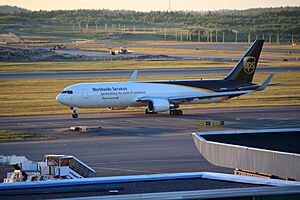
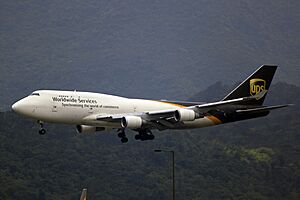
UPS Airlines is the fourth-largest cargo airline in the world. It flies to over 800 places worldwide. This is more than any other airline, cargo or passenger. The airline started in 1988. Its main office is in Louisville, Kentucky. This is also where its worldwide air hub, Worldport, is located. It has other hubs in the United States in Ontario, California, Dallas, Texas, Rockford, Illinois, and Philadelphia. Outside North America, a hub in Cologne, Germany, serves Europe. In Asia, UPS Airlines has a facility in Hong Kong and two hubs in mainland China.
The airline has almost 300 aircraft as of 2025. It competes directly with FedEx Express. UPS Airlines helps the company send air shipments to over 200 countries and territories.
UPS Drone Airline
UPS Flight Forward is a special part of UPS that started in July 2019. It was the first company to get a special certification from the FAA called Part 135 Standard. This certification allows UPS to fly an unlimited number of drones of any size. The drones can even carry cargo heavier than 55 pounds. They can also have an unlimited number of remote operators.
UPS Brand and Colors
The Color Brown
The brown color that UPS uses on its vehicles and uniforms is called Pullman brown. The company's founder, James E. Casey, first wanted the vehicles to be yellow. But one of his partners, Charlie Soderstrom, said that yellow vehicles would be hard to keep clean. He pointed out that Pullman railroad cars were brown for that very reason.
In the 2000s, the company used its famous brown color in an advertising slogan: "What can Brown do for you?"
UPS Font
UPS asked a company called FutureBrand to create its own special font, UPS Sans. This font is used in marketing and communication materials. UPS Sans was made by slightly changing parts of another font called FF Dax without permission. This led to an agreement between the two companies to avoid legal issues.
Reputation
UPS has sometimes been criticized for how it treats its workers. This includes concerns about not providing enough protection or sick leave during the COVID-19 pandemic.
The company has also faced criticism for packages that were damaged, late, or handled incorrectly.
People who advocate for safe streets have criticized UPS and other delivery services. They say these companies often park their vehicles illegally in bike lanes while making deliveries. This practice can be dangerous for cyclists. UPS was sued over this in New York in 2015. They were also criticized by Washington, D.C.'s transportation agency in 2018.
UPS and the Environment
As of 2013, UPS has over 104,900 vehicles worldwide. Nearly 7,000 of these use alternative fuels. In May 2008, UPS ordered 200 hybrid electric vehicles. They also ordered 300 compressed natural gas vehicles. These gas vehicles are 20% more fuel efficient. In 2016, the company added 200 more hybrid electric vehicles to its fleet.
UPS received a good rating from the Climate Counts Group for its efforts to reduce its impact on the environment. UPS also won the Clean Air Excellence Award from the United States Environmental Protection Agency. This was for its alternative fuel program. However, a few years later, the Environmental Protection Agency fined UPS for not following environmental laws.
In October 2009, UPS became the first small-package carrier to let customers buy carbon offsets. These offsets help balance out the greenhouse gas emissions from transporting their packages. This option is now widely available through UPS shipping systems.
Carbon Footprint
UPS reported its total CO2e emissions for the year ending December 31, 2020. It was 16,500 kilotonnes. This was a 10% increase from the year before. UPS aims to have net zero emissions by 2050.
See also
 In Spanish: United Parcel Service para niños
In Spanish: United Parcel Service para niños


